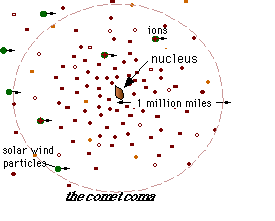This picture shows the shape and size of the orbit of Comet Wild 2. The comet's orbit is aqua. You can also see the orbits of Jupiter, Mars, and Earth.
Click on image for full size
NASA/JPL
Comet Wild 2
Comet Wild 2 is named after the scientist who discovered it. Paul Wild
is an astronomer from Switzerland who discovered the comet in January
1978. Wild 2 is
pronounced "Vilt 2".
The comet orbits the Sun once every
6.39 years, which is a pretty short time for a comet. Some comets take
more than 100 years to go around the
Sun one time! The comet's orbit is not a circle. Its orbit is shaped
more like an oval, which astronomers call an ellipse. When the comet
is at one end of the ellipse it is as close to the Sun as it gets. When
it is at the other end, it is far from the Sun. The orbit of Wild 2 brings
it a bit closer to the Sun than the planet Mars.
The orbit also swings the comet out beyond the orbit of Jupiter.
When we see a comet from Earth, we actually see the dust and gas the
comet gives off. The dust and gas form a fuzzy head called the "coma"
and tails that are thousands of kilometers (miles) long. The solid part
of a comet is called the nucleus, and is in the middle of the coma. The
nucleus of Wild 2 is only about five km (three miles) across.
A spacecraft named Stardust flew
by Comet Wild 2 in January 2004. I took some very
nice pictures of the nucleus and gathered some dust samples.
It will bring
the dust back to Earth so scientists can study it.
You might also be interested in:

As the ices of the comet nucleus evaporate, they expand rapidly into a large cloud around the central part of the comet. This cloud, called the coma, is the atmosphere of the comet and can extend for millions
...more
The picture on this page shows the best views ever of the nucleus of a comet. It shows two pictures of the comet's nucleus that were taken at slightly different times. The pictures were taken by a spacecraft
...more
Stardust is the name of a space mission that studied a comet. NASA's Stardust spacecraft flew past a comet named Wild 2 in January 2004. During its flyby Stardust collected some dust particles from the
...more
Scientists have found a type of amino acid in a sample returned from a comet. Amino acids are the building-blocks of proteins. Proteins are one of the most important types of molecules in living creatures.
...more
Comet Wild 2 is named after the scientist who discovered it. Paul Wild is an astronomer from Switzerland who discovered the comet in January 1978. Wild 2 is pronounced "Vilt 2". The comet orbits the Sun
...more
Hale-Bopp continues to offer new surprises as two astronomers report of their study of the comet. Using the Hubble Space Telescope and the International Ultraviolet Explorer, the astronomers did a year-long
...more
Six spacecraft flew by Halley's comet in 1986. There were two spacecraft launched from Japan, Suisei and Sakigake, and two from the Soviet Union, Vega 1 & 2. One spacecraft, ICE, from the United States
...more














